Related Content
Content
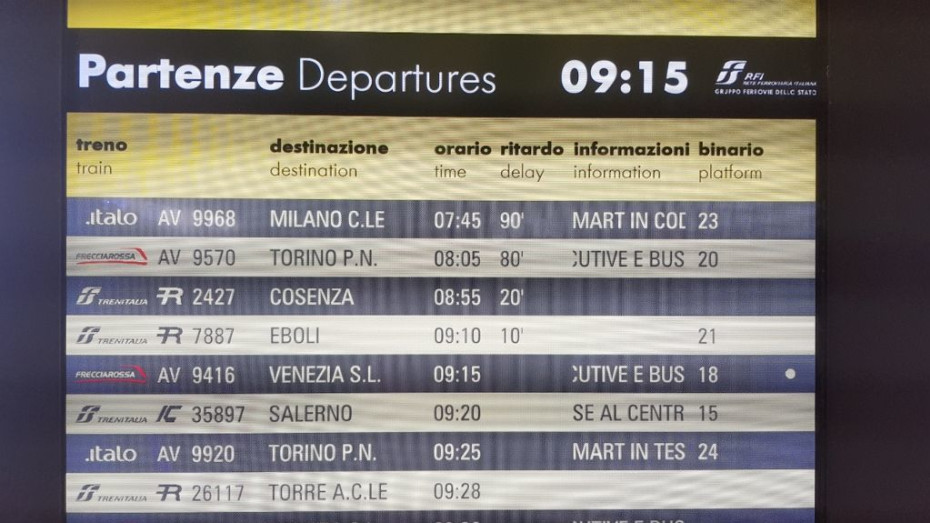
The Language of Train Travel
This guide to the vocabulary of European train travel helps explain the terms and phrases you may see at stations, on timetables and on websites
Share
Introduction
Make some train journeys in Europe and you’ll soon realise that multiple words and terms are unique to train travel.
If you’re new to travelling by train in Europe this language of train travel can be somewhat confusing, hence this guide.
In our efforts to make the complexities of train travel easier to understand on a smart phone, we have on occasion resorted to short cuts for certain train journey specific terms and phrases on ShowMeTheJourney.
Though we appreciate our audacity in adding to this train journey vocabulary, may not be hugely helpful to those who aren’t used to travelling by train.
So this guide also includes these train journey specific terms we have utilised – some of which we have borrowed or adapted from the train operators and the ticket agents.
What is a terminus station?
This is a station where the concourse, the area in which you wait for the details of the train you will be taking to be confirmed (etc) is at one end of the platforms/tracks.
Meaning that when changing trains you simply have to walk passed the front of the train directly on to the concourse.
From the concourse you can also access the platform/track that your next train will be leaving from.
Examples of this type of station include Frankfurt (Main) hbf; Munchen Hbf pictured below and Milano Centrale.
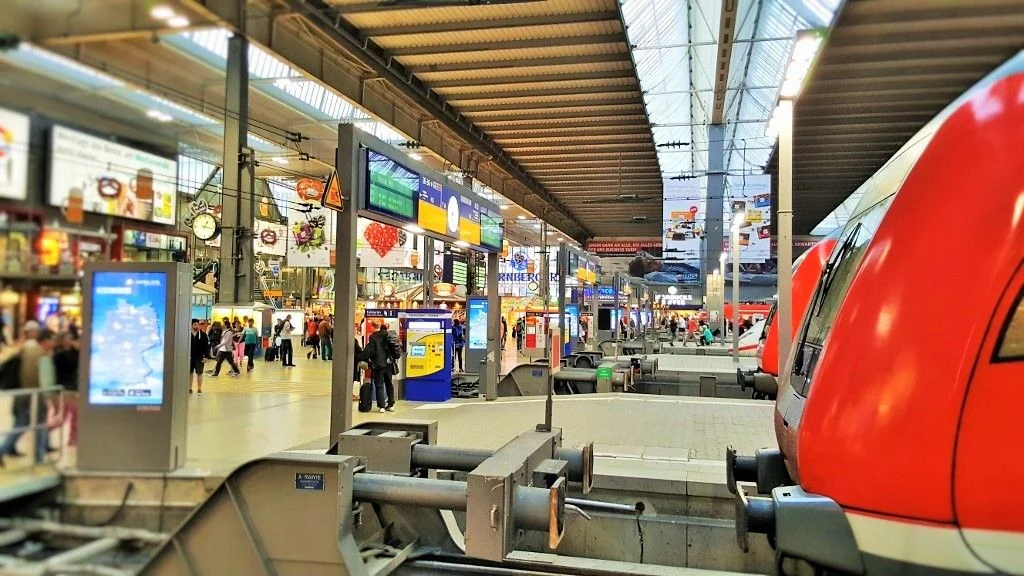
So they’re particularly easy stations in which to change trains, which is why we have made the distinction.
Many (but not all) terminus stations are also at street level, though at most short flights of stairs and slopes usually connect the station buildings to the streetscape.
Another characteristic of terminus stations is that the trains don’t pass through the station, so trains that are calling on route to a final destination have to reverse direction.
Which can be confusing because the English language name ‘Terminus’ suggests that trains reach their final destinations at stations of this type – but on mainland Europe that often isn’t the case.
What is a zone?
In Austria, France, Germany, Switzerland and increasingly in Italy, at stations used by express trains the platforms/tracks are divided into zones.
The idea being that you can wait in a specific zone for the train you are boarding to arrive.
These zones aren’t usually marked on the track/platform itself, but are indicated by signs.
In this image below of the platform (track/gleis) at a German hauptbahnhof station, the letter B signs are indicating the location of zone B.
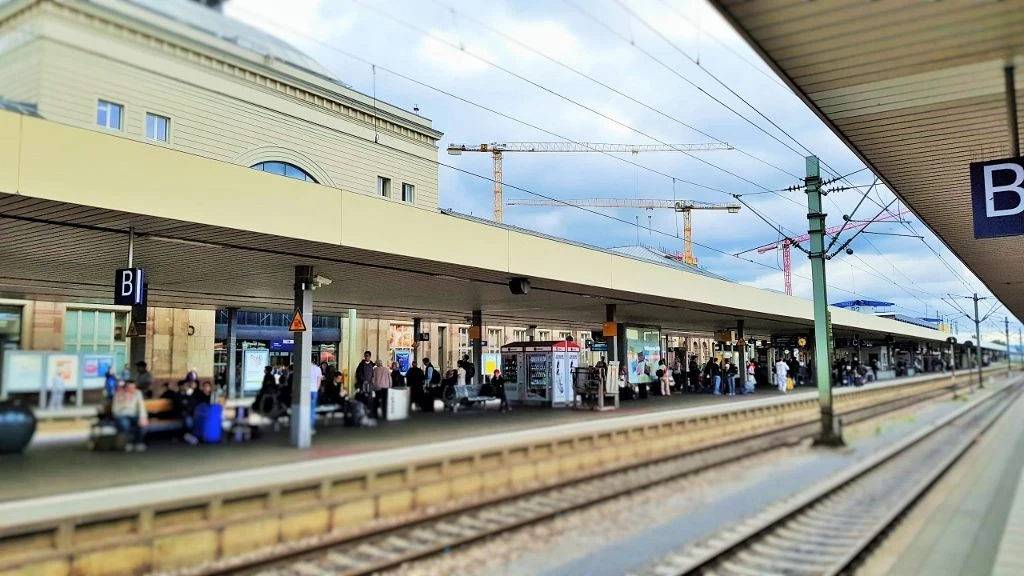
In Austria, France and Germany other signs on the platform/track ALSO indicate which specific coach of the train will occupy each zone.
At MAJOR stations in Italy the carriage/coach numbers are shown on electronic screens with a red background
So in Austria, France, Germany and Italy you can match the coach number on your ticket to the coach numbers on the zone information, so you’ll know where to wait for easy boarding into the specific coach, in which your reserved seat is located.
In Switzerland the zone information only shows the approximate location of 1st class, 2nd class and the restaurant coaches/cars.
Meaning of 'online bookings open USUALLY'?
When travelling on express trains in virtually all European countries (Belgium, Luxembourg and The Netherlands are the major exceptions) you can save money by booking in advance – and the earlier you book the more money you are likely to save.
The logic being that the limited numbers of most heavily discounted tickets inevitably sell out fastest of all.
Hence our efforts to show the earliest opportunity when the booking windows usually open – in other words when the tickets will be placed on sale.
However, the key word we’re drawing your attention to here is ‘usually’.
Most European train operators and entire countries have an annual major update to the train timetables/schedules on the second weekend in December.
These new or updated schedules are inevitably confirmed months in advance, but, if you are booking online between early August and early November during that time you may not be able to book tickets on certain routes if you want to travel after the second weekend in December.
That's because the tickets won’t be released for sale, until the new schedules are confirmed.
So in September and October the booking windows may be shortened.
What are compulsory / mandatory reservations?
When booking tickets on some express train services, seats will be automatically be assigned - the seat(s) numbers will be shown on your ticket.
These are tickets that have compulsory reservations factored into them, a ticket = a guaranteed, assigned seat for the journey
However, if you will be travelling with a rail pass, you MUST book these reservations, so that you also have an assigned seat.
So if you will be using a Eurail or Interrail Pass you will need to pay a reservation fee, prior to boarding.
What is a rail pass?
Rail passes are alternatives to having to buy separate tickets for each journey you take by train.
If you have a rail pass you can take as many trains as you want in the area covered by your pass, on the day(s) it is valid for.
Many countries offer rail passes that can be used in specific regions popular with tourists – they can be accessed from each country’s ‘Ticket & Pass Guides’.
However on ShowMeTheJourney when we refer to ‘Rail Pass Users’ on our journey guides we are referring to travellers using Eurail, Interrail or Swiss Travel Passes.
We've also now published our guide to getting the most out of using a Eurail or Interrail Pass, but we’re big fans – without Interrail it wouldn’t have been possible to produce ShowMeTheJourney.
What is a rail pass 'reservation fee'?
A big plus of using a rail pass is saving the bother of having to buy tickets online or at stations, but if you’re using a Eurail or Interrail pass you can no longer just hop on ANY train.
Before boarding trains or making journeys with compulsory reservations, you will need to purchase a rail pass reservation, so that you also have an assigned seat/bed on the train.
So the rail pass reservation fees are the costs of these reservations, which are also known as ‘supplements’.
(Swiss Travel Pass users don’t have to be aware of these fees as no regular train services within Switzerland have compulsory reservations).
In Austria, Belgium, Denmark, Germany, Great Britain, Luxembourg and The Netherlands the express trains either don’t have compulsory reservations, or reservations aren’t an option.
Though if you will be travelling with a rail pass and choose not to reserve on a train service on which reservations are optional, seats may not be available.
What do you mean by 'train specific tickets'?
A universal rule of European train travel is that if you book the most heavily discounted, cheapest tickets, you can only use them on the specific train you have opted to travel by - departing at the time that will be printed on the ticket.
Therefore on ShowMeTheJourney we refer to such tickets as 'train specific tickets'.
If you don’t want to be tied to a specific train/departure take care when booking online - nearly always the dominant price you will see for a journey will be for a train-specific ticket.
That’s because train specific tickets will be cheaper and the ticket agents usually promote the cheapest possible price for a specific journey - by making it look more prominent when looking up journeys.
Alternative, less restrictive tickets will nearly always be available - this matters because the most heavily discounted train specific tickets nearly always can’t be refunded if you subsequently change your travel plans.
And if you miss a departure in circumstances that aren’t directly connected to the train operator - such as a taxi stuck in traffic, they also can’t be transferred to an alternative departure without payment of a fee - or at all!
So check the terms and conditions when making a booking – train specific tickets may not be the best option.
What do you mean by 'end to end tickets'?
Many popular train journeys across Europe involve a change of train.
However, many of the cheapest tickets for such journeys that involve two or more express trains are train specific (see above) and this can apply to all the trains you will be taking in order to complete a journey..
In those instances you have to take each specific train printed on the ticket(s) you have been issued.
On ShowMeTheJourney we refer to such tickets as end-to-end tickets.
They’re worth paying attention to, as the majority of ticket agents assume that all travellers want to reach their final destinations in the fastest possible time.
So when looking up such journeys, what can be easy to miss is that the connections between trains on such journeys can be tightly timed.
What do you mean by 'transferring tickets'?
What we’re NOT referring to when we use this term on our Popular Journey guides is instances when you have booked a ‘train-specific’ ticket, but then want/need to take an alternative departure due to circumstances outside of the train operator’s control - change of travel plans, an over-running meeting etc.
What we ARE referring to is when you have booked an end-to-end ticket (see above), but you have missed a connection on to a subsequent specific train that you were booked on to - because a train has arrived too late at a station for the booked connection to be made.
In such circumstances, if you are making an end-to-end international journey between countries that are members of Railteam (Austria, Belgium, France, Germany, Great Britain, Luxembourg, Switzerland and The Netherlands and on TGV France-Italy services) you can transfer your tickets and reservations FREE OF CHARGE to alternative later departures.
This also usually applies if you are making an end-2-end journey within a country and have train specific tickets for a train that you will be connecting into.
Seek out the conductor/train manager and ask their advice about what steps you need to take.
However, if you will be making a connection and the ticket for the next train ISN'T train-specific, you will be able to use your ticket on any subsequent train on to your final destination.
What do you mean by connection not guaranteed'?
Because 5 – 10% of European express trains run at least 10 mins late SMTJ recommends allowing 30min – 1hr to transfer between trains when booking end-to-end tickets.
That’s partially because changing trains against the clock at a station you’re not familiar with can take the pleasure out of journeys, but it’s mainly because the majority of the connections on end-to-end tickets aren’t guaranteed.
What we mean by this is that the subsequent train, you are specifically booked to travel on will USUALLY depart on time (if it isn’t running late as well) irrespective of when the train you are connecting FROM, will actually be arriving at a station.
The train you are connecting into MAY delay its departure if the train you’re on isn’t running particularly late and if a high percentage of travellers will typically be making a transfer – but that is not always the case.
So there is a risk of not catching the subsequent train you are booked on to (OR the next train on to your final destination) – and this risk increases the shorter the time you have available to make the connection.
On our journey guides we have striven to specifically draw your attention when this IS the case.
Although if you will be making connections in Switzerland or The Netherlands, this ISN'T something you need to worry about.
What do you mean by a 'domestic' train service?
A tiny fraction of European train routes/journeys/services are international, but the majority operate solely within a country and don’t cross borders.
On ShowMeTheJourney we have referred to these journeys within a country’s borders as domestic – which we have just realised when writing this sentence, may not have been the optimum word to have chosen, but we’re stuck with it now.
What is a regular timetable?
If a train service departs at similar intervals during the day - hourly, every 30 mins, every other hour etc then this is a regular timetable.
What does 'departs in the same minutes in every hour' mean?
On most regular timetables the timings of the departures are fixed so that trains leave at 09:16; 10:16. 11:16 etc - and when that is the case the term ‘same minutes past every hour is used’.
What does 'departs in even or odd hours only' mean?
On 'regular timetables' a train service can depart every other hour, or in other words, every two hours.
When that is the case if the train service departs at 08:16; 10:16 etc it is departing in even hours only, if the train is departing at 09:16; 11:16 etc it is departing in odd hours only.
What is a couchette?
A couchette is a compartment on an overnight train in which bunks are available. Basic bedding such as pillows are usually provided.
A key difference with a sleeping cabin is that if you travel in a couchette you sleep in your daytime clothes.
Another key difference is that there will be four or more usually six bunks/berths in a couchette, compared to the maximum of three beds that will be available in a sleeping cabin.
What is a train number?
Many European countries including Austria, France, Germany, Italy, Poland, Spain, Sweden and The Czech Republic use a train numbering system.
The national train operators in these and other countries assign a three, four or five digit numbers to each train journey they operate.
These numbers are retained throughout the course of a journey, therefore they are different to arrival and departure times - so take care not to confuse them.
For example, the national train operator in Italy, Trenitalia, assigns the number '8809' to the Frecciabianca train service which departs daily from Milano at 10:35 and arrives at its final destination, Bari at 20:35.
This number 8809 is assigned to the train during its entire journey.
So the 12:42 train from Bologna to Bari will also have the number 8809, it is the same train that left Milano at 10:35.
If you will be travelling from Rimini to Pescara at 13:40, you will also be travelling on train 8809, it will have come from Milano and will be travelling on beyond Pescara to Bari
Being aware of this train number can be important, an Italian traveller could think 'I'm taking train number 8809 to Bari' instead of 'I'm taking the 10:35 train to Bari'.
If you have a ‘train-specific’ ticket (see above) for a journey in a country that uses train numbers, this train number will be printed on your ticket.
It will be a different number to the departure time, but at the station it can help you to find your train.
In many countries including Austria, France, Germany, Italy and Spain, the train number is included on the electronic departure screens at stations, in addition to the departure times.
On the image below of a departure board at an Italian station, the train numbers are the four and five digit numbers in the column second from the left.
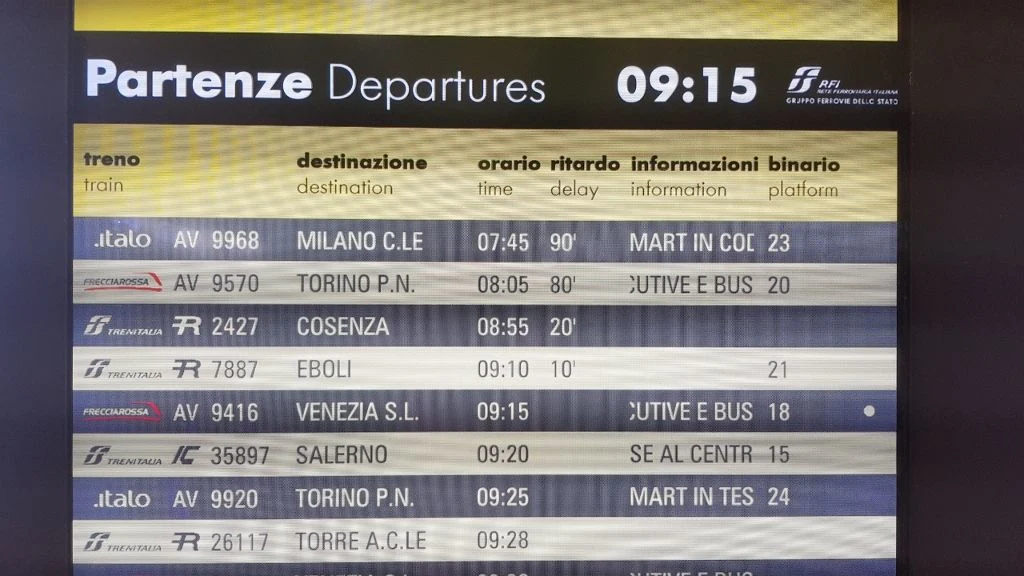
When looking at a departure board, you might not see the station you are heading to listed on the information, but what you will see is the train number.
So matching the train number on your ticket, to the train number on the departure screen, can be the best method of working out which train you need to take - and which platform/track it will be leaving from.
What do you mean by a 'type of train' and 'train service'?
This can be a particularly alien concept to British travellers, but in virtually every other European country the train you will be travelling by will have specific facilities and rules (terms and conditions of travel) assigned to it.
If you’re not used to travelling on such trains, these ‘rules’ won’t be particularly obvious, but they can make a huge difference to the travel experience, the booking of tickets and using rail passes – hence Show Me The Journey always strives to show which type(s) of train/train service you will be travelling on when making a journey.
So whenever it is possible, we refer to a specific type of train, a Railjet or a Frecciarossa etc.
Though on some routes, the specific type of train you will be travelling by can vary, but the terms and conditions are common to particular ‘service’ – for example book a 1st class ticket on any ICE train service and your seats will be assigned because the reservation is complimentary.
However there are differences between specific types of ICE trains, ICE 1 trains have restaurant cars, ICE 3 trains have ‘lounges’ at each end of the train etc.
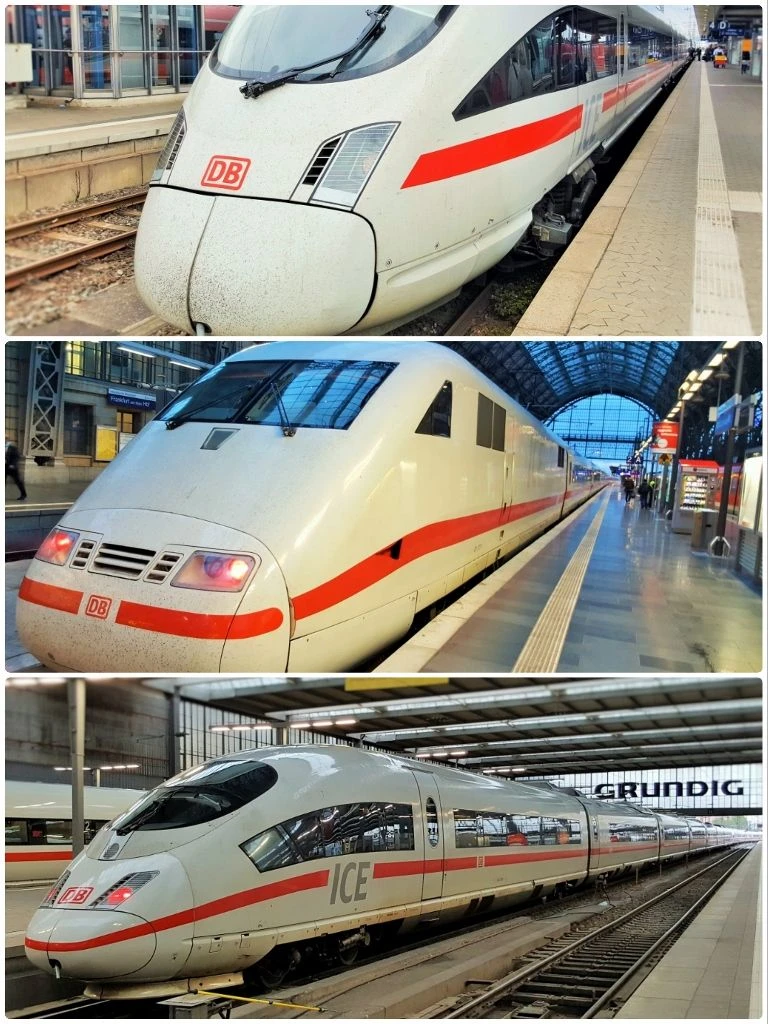
So we also try to be specific about whether you will be travelling on an ICE 1 train or an ICE T train etc because the on board ambience of each train is quite different, though the ticketing terms on all ICE trains are the same.
So if, for example, we use ICE and not ICE 1 or ICE 3 etc, we are referring to the general service of ICE trains and not a specific type of ICE train.
Another example is that dozens of different types of train are used on TER services across France, but what they all have in common is that seats can’t be reserved and no catering is available etc.
What do you mean by a 'partial high speed line'?
At ShowMeTheJourney we’re big fans of high speed rail travel (when all the disruption and costs involved in building the high speed line are justified), but if you board a high speed ‘train’ it doesn’t automatically follow that you will be about to travel exceptionally fast.
Some journeys by high speed ‘train’ don’t include high speed lines at all – the trains need to access more places than the lines serve - while on other journeys you will be travelling at high speed for only a percentage of the journey.
This percentage of the journey that is high speed can be quite small, so in order to help manage expectations of a journey, we have used the term ‘partial’ for when only some of the journey is on high speed lines.
What do you mean by 'on the left' or 'on the right' of a train?
Take a look at our journey guides when the journey happens to be scenic and you will hopefully come to appreciate when we have gone the extra mile, in order to tell you which side of the train you should take a seat on.
The reason being is that on many scenic routes the views that will thrill and delight can predominantly only be seen from one side of the train and not the other.
When we say ‘sit on the left’ or ‘sit on the right’ we’re referring to the direction of travel and not your left or right hands.
You need to face towards the direction the train will be travelling in and then you choose seats on the left or right.
Please support ShowMeTheJourney
This second version of ShowMeTheJourney is exciting and new, so we are genuinely thrilled that you are here and reading this, but we also need your help.
We’re striving not to let anything get in the way of providing the most useful service possible, hence a facility has been set up with DonorBox which can be used to support the running costs and make improvements.
Instead of advertising or paywalls, your financial support will make a positive difference to delivering an enhanced service, as there’s a lot of ideas which we want to make happen.
So if you have found the info provided here to be useful, please go here to say thank you.

Simon Harper
I wanted to share my passion for train travel and explain how anyone can take the fantastic journeys I have taken.

This is one of more than 100 train travel guides available on ShowMeTheJourney, which will make it easier to take the train journeys you want or need to make. As always, all images were captured on trips taken by ShowMeTheJourney.
This second version of ShowMeTheJourney is exciting and new, so we are genuinely thrilled that you are here and reading this, but we also need your help.
We’re striving not to let anything get in the way of providing the most useful service possible, hence a facility has been set up with DonorBox which can be used to support the running costs and make improvements.
Instead of advertising or paywalls, your financial support will make a positive difference to delivering an enhanced service, as there’s a lot of ideas which we want to make happen.
So if you have found the info provided here to be useful, please consider saying thank you.



